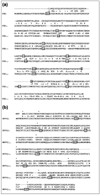Comparison of complete nuclear receptor sets from the human, Caenorhabditis elegans and Drosophila genomes
- PMID: 11532213
- PMCID: PMC55326
- DOI: 10.1186/gb-2001-2-8-research0029
Comparison of complete nuclear receptor sets from the human, Caenorhabditis elegans and Drosophila genomes
Abstract
Background: The availability of complete genome sequences enables all the members of a gene family to be identified without limitations imposed by temporal, spatial or quantitative aspects of mRNA expression. Using the nearly completed human genome sequence, we combined in silico and experimental approaches to define the complete human nuclear receptor (NR) set. This information was used to carry out a comparative genomic study of the NR superfamily.
Results: Our analysis of the human genome identified two novel NR sequences. Both these contained stop codons within the coding regions, indicating that both are pseudogenes. One (HNF4 gamma-related) contained no introns and expressed no detectable mRNA, whereas the other (FXR-related) produced mRNA at relatively high levels in testis. If translated, the latter is predicted to encode a short, non-functional protein. Our analysis indicates that there are fewer than 50 functional human NRs, dramatically fewer than in Caenorhabditis elegans and about twice as many as in Drosophila. Using the complete human NR set we made comparisons with the NR sets of C. elegans and Drosophila. Searches for the >200 NRs unique to C. elegans revealed no human homologs. The comparative analysis also revealed a Drosophila member of NR subfamily NR3, confirming an ancient metazoan origin for this subfamily.
Conclusions: This work provides the basis for new insights into the evolution and functional relationships of NR superfamily members.
Figures



References
-
- The Arabidopsis Genome Initiative Analysis of the genome sequence of the flowering plant Arabidopsis thaliana. Nature. 2000;408:796–815. - PubMed
-
- Giguere V. Orphan nuclear receptors: from gene to function. Endocr Rev. 1999;20:689–725. - PubMed
-
- McKenna NJ, Lanz RB, O'Malley BW. Nuclear receptor coregulators: cellular and molecular biology. Endocr Rev. 1999;20:321–344. - PubMed
-
- Sluder AE, Mathews SW, Hough D, Yin VP, Maina CV. The nuclear receptor superfamily has undergone extensive proliferation and diversification in nematodes. Genome Res. 1999;9:103–120. - PubMed
Publication types
MeSH terms
Substances
LinkOut - more resources
Full Text Sources
Other Literature Sources
Molecular Biology Databases

